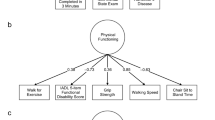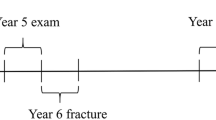Abstract
The purpose of this study was to examine, prospectively, the risk of non-vertebral fractures and low bone mineral density in a population-based cohort with respect to indicators of subjective mental distress. In 1979–1980 all males born 1925–1959 and all females born 1930–1959 living in Tromsø were invited (21,441; response rate, 78%). The same individuals were invited to the subsequent studies in 1986–1987 and 1994–1995 (74% attended the first two, and 71% attended all three surveys). Non-vertebral fractures were registered by linkage to the hospital X-ray register for the period 1988–1995, and forearm bone mineral density (BMD) was available in a subsample of 4,690 who had attended three times. Questions about mental distress (depression, insomnia and coping problems) were repeated three times and analyzed as cumulated exposure. Women who reported being depressed at two time points had an adjusted odds ratio (OR) =2.5 (95% confidence interval [CI] 1.3–4.9) for sustaining a non-vertebral fracture and OR=3.1 (95% CI 1.3–7.2) for sustaining an osteoporotic fracture, compared with those without depression on any occasion. The corresponding odds ratios for those with coping problems at two time points were slightly higher, whereas sleeping problems seem only to be weakly associated with non-vertebral fractures. The pattern of associations and the magnitude of OR estimates were mainly the same in women younger than 50 years and those 50 years and older. Women using nerve medicine and reporting depression twice had an odds ratio of 4.4 (95% CI 1.1–17.7) for sustaining a non-vertebral fracture, and those using nerve medicine and reporting coping problems twice had a corresponding OR 4.7 (95% CI 1.2–18.4). Among men no significant associations were found for either fracture type. No association was found between mean BMD and number of times reporting depression, insomnia or coping problems, in women or men. Long-term mental distress is associated with risk of all non-vertebral fractures and osteoporotic fractures in middle-aged women, but not in men. Mental distress itself seems to be more important than the use of nerve medicine.


Similar content being viewed by others
References
Forsen L, Meyer HE, Sogaard AJ, Naess S, Schei B, Edna TH (1999) Mental distress and risk of hip fracture. Do broken hearts lead to broken bones? J Epidemiol Community Health 53:343–347
Whooley MA, Kip KE, Cauley JA, Ensrud KE, Nevitt MC, Browner WS (1999) Depression, falls, and risk of fracture in older women. Study of Osteoporotic Fractures Research Group. Arch Intern Med 159:484–490
Wells KB, Sturm R, Sherbourne CD, Meredith LS (1996) Caring for depression. Harvard University Press, Cambridge, MA, USA
Weissman MM, Bland RC, Canino GJ, Faravelli C, Greenwald S, Hwu HG et al (1996) Cross-national epidemiology of major depression and bipolar disorder. JAMA 276:293–299
Granek E, Baker SP, Abbey H, Robinson E, Myers AH, Samkoff JS, Klein LE (1987) Medications and diagnoses in relation to falls in a long-term care facility. J Am Geriatr Soc 35:503–511
Herings RM, Stricker BH, de Boer A, Bakker A, Sturmans F (1995) Benzodiazepines and the risk of falling leading to femur fractures. Dosage more important than elimination half-life. Arch Intern Med 155:1801–1807
Thapa PB, Gideon P, Fought RL, Ray WA (1995) Psychotropic drugs and risk of recurrent falls in ambulatory nursing home residents. Am J Epidemiol 142:202–211
Mendelson WB (1996) The use of sedative/hypnotic medication and its correlation with falling down in the hospital. Sleep 19:698–701
Leipzig RM, Cumming RG, Tinetti ME (1999) Drugs and falls in older people: a systematic review and meta-analysis: I. Psychotropic drugs. J Am Geriatr Soc 47:30–39
Cumming RG, Le Couteur DG (2003) Benzodiazepines and risk of hip fractures in older people: a review of the evidence. CNS Drugs 17:825–837
Liu B, Anderson G, Mittmann N, To T, Axcell T, Shear N (1998) Use of selective serotonin-reuptake inhibitors of tricyclic antidepressants and risk of hip fractures in elderly people. Lancet 351:1303–1307
Biderman A, Cwikel J, Fried AV, Galinsky D (2002) Depression and falls among community-dwelling elderly people: a search for common risk factors. J Epidemiol Community Health 56:631–636
Tinetti ME (2003) Clinical practice. Preventing falls in elderly persons. N Engl J Med 348:42–49
Cizza G, Ravn P, Chrousos GP, Gold PW (2001) Depression: a major, unrecognized risk factor for osteoporosis? Trends Endocrinol Metab 12:198–203
Halbreich U, Rojansky N, Palter S, Hreshchyshyn M, Kreeger J, Bakhai Y, Rosan R (1995) Decreased bone mineral density in medicated psychiatric patients. Psychosom Med 57:485–491
Michelson D, Stratakis C, Hill L, Reynolds J, Galliven E, Chrousos G, Gold P (1996) Bone mineral density in women with depression. N Engl J Med 335:1176–1181
Greendale GA, Unger JB, Rowe JW, Seeman TE (1999) The relation between cortisol excretion and fractures in healthy older people: results from the MacArthur studies-Mac. J Am Geriatr Soc 47:799–803
Vrkljan M, Thaller V, Lovricevic I, Gacina P, Resetic J, Bekic M, Sonicki Z (2001) Depressive disorder as possible risk factor of osteoporosis. Coll Antropol 25:485–492
Horrobin DF, Bennett CN (1999) Depression and bipolar disorder: relationships to impaired fatty acid and phospholipid metabolism and to diabetes, cardiovascular disease, immunological abnormalities, cancer, ageing and osteoporosis. Possible candidate genes. Prostaglandins Leukot Essent Fatty Acids 60:217–234
Kiecolt-Glaser JK, Glaser R (2002) Depression and immune function: central pathways to morbidity and mortality. J Psychosom Res 53:873–876
Ducy P, Amling M, Takeda S, Priemel M, Schilling AF, Beil FT et al (2000) Leptin inhibits bone formation through a hypothalamic relay: a central control of bone mass. Cell 100:197–207
Halbreich U, Palter S (1996) Accelerated osteoporosis in psychiatric patients: possible pathophysiological processes. Schizophr Bull 22:447–454
Schweiger U, Deuschle M, Korner A, Lammers CH, Schmider J, Gotthardt U et al (1994) Low lumbar bone mineral density in patients with major depression. Am J Psychiatry 151:1691–1693
Yazici KM, Akinci A, Sutcu A, Ozcakar L (2003) Bone mineral density in premenopausal women with major depressive disorder. Psychiatry Res 117:271–275
Amsterdam JD, Hooper MB (1998) Bone density measurement in major depression. Prog Neuropsychopharmacol Biol Psychiatry 22:267–277
Kavuncu V, Kuloglu M, Kaya A, Sahin S, Atmaca M, Firidin B (2002) Bone metabolism and bone mineral density in premenopausal women with mild depression. Yonsei Med J 43:101–108
Coelho R, Silva C, Maia A, Prata J, Barros H (1999) Bone mineral density and depression: a community study in women. J Psychosom Res 46:29–35
Reginster JY, Deroisy R, Paul I, Hansenne M, Ansseau M (1999) Depressive vulnerability is not an independent risk factor for osteoporosis in postmenopausal women. Maturitas 33:133–137
Kritz-Silverstein D, Barrett-Connor E (1997) Depressed mood and bone mineral density in older men and women: the Rancho Bernardo Study. J Bone Miner Res 12S1:S251
Schweiger U, Weber B, Deuschle M, Heuser I (2000) Lumbar bone mineral density in patients with major depression: evidence of increased bone loss at follow-up. Am J Psychiatry 157:118–120
Robbins J, Hirsch C, Whitmer R, Cauley J, Harris T (2001) The association of bone mineral density and depression in an older population. J Am Geriatr Soc 49:732–736
Joakimsen RM, Fonnebo V, Magnus JH, Stormer J, Tollan A, Sogaard AJ (1998) The Tromso Study: physical activity and the incidence of fractures in a middle-aged population. J Bone Miner Res 13:1149–1157
Joakimsen RM (1999) The Tromsø Study. Risk factors for non-vertebral fractures in a middle-aged population. Thesis. ISM skriftserie No. 47. Institute of Community Medicine, University of Tromsø, Norway
Berntsen GK, Fonnebo V, Tollan A, Sogaard AJ, Magnus JH (2001) Forearm bone mineral density by age in 7,620 men and women: The Tromso study, a population-based study. Am J Epidemiol 153:465–473
Joakimsen RM, Fonnebo V, Sogaard AJ, Tollan A, Stormer J, Magnus JH (2001) The Tromso study: registration of fractures—how good are self-reports, a computerized radiographic register and a discharge register? Osteoporos Int 12:1001–1005
Berntsen GK, Tollan A, Magnus JH, Sogaard AJ, Ringberg T, Fonnebo V (1999) The Tromso study: artifacts in forearm bone densitometry—prevalence and effects. Osteoporos Int 10:425–432
Søgaard AJ, Bjelland I, Tell GS, Røysamb E (2003) A comparison of the CONOR Mental Health Index to the HSCL-10 and HADS. Measuring mental health status in The Oslo Health Study and the Nord-Trøndelag Health Study. Nor J Epidemiol 13:279–284
Bjartveit K, Foss OP, Gjervig T (1983) The cardiovascular disease study in Norwegian counties. Results from first screening. Acta Med Scand [Suppl] 675:1–184
Dargent-Molina P, Favier F, Grandjean H, Baudoin C, Schott AM, Hausherr E et al (1996) Fall-related factors and risk of hip fracture: the EPIDOS prospective study. Lancet 348:145–149. Erratum in: Lancet 1996 348:416
Lawlor DA, Patel R, Ebrahim S (2003) Association between falls in elderly women and chronic diseases and drug use: cross-sectional study. BMJ 327:712–717
Stalenhoef PA, Diederiks JP, Knottnerus JA, Kester AD, Crebolder HF (2002) A risk model for the prediction of recurrent falls in community-dwelling elderly: a prospective cohort study. J Clin Epidemiol 55:1088–1094
Ray WA, Griffin MR, Schaffner W, Baugh DK, Melton LJ 3rd (1987). Psychotropic drug use and the risk of hip fracture. N Engl J Med 316:363–369
Ruthazer R, Lipsitz LA (1993) Antidepressants and falls among elderly people in long-term care. Am J Public Health 83:746–749
Cumming RG (1998) Epidemiology of medication-related falls and fractures in the elderly. Drugs Aging 12:43–53
Thapa PB, Gideon P, Cost TW, Milam AB, Ray WA (1998) Antidepressants and the risk of falls among nursing home residents. N Engl J Med 339:875–882
Salin Y (1990) Occurrence of fractures in a defined population: a 1-year study. Injury 21:158–160
Ito M, Matsumoto T, Enomoto H, Tsurusaki K, Hayashi K (1999) Effect of nonweight bearing on tibial bone density measured by QCT in patients with hip surgery. J Bone Miner Metab 17:45–50
Berntsen GKR (2000) Interpretation of forearm bone mineral density. Thesis. ISM skriftserie No. 56. Institute of Community Medicine, University of Tromsø, Tromsø, Norway
Kleinbaum DG, Kupper LL, Morgenstern H (1982) Selection Bias. In: Kleinbaum DG, Kupper LL, Morgenstern H (eds) Epidemiologic research. Van Nostrand Reinhold, New York, pp 194–219
Rothman KJ, Greenland S (1998) Precision and validity in epidemiological studies. In: Rothman KJ, Greenland S (eds) Modern epidemiology, 2nd edition. Lippincott–Raven, Philadelphia, pp 115–134
Jacobsen BK, Hasvold T, Hoyer G, Hansen V (1995) The General Health Questionnaire: how many items are really necessary in population surveys? Psychol Med 25:957–961
Forsen L (1999) Hip fracture. Risk factors and excess mortality. Epidemiological studies in the Norwegian county of Nord-Trøndelag. National Institute of Public Health, Department of Public Health Sciences, Oslo, Norway
Acknowledgements
The Tromsø Study was conducted in joint collaboration with the National Health Screening Service (now the Norwegian Institute of Public Health). We want to thank the Norwegian Osteoporosis Society and the Norwegian Foundation for Health and Rehabilitation for their financial support of this particular part of the study.
Author information
Authors and Affiliations
Corresponding author
Rights and permissions
About this article
Cite this article
Søgaard, A.J., Joakimsen, R.M., Tverdal, A. et al. Long-term mental distress, bone mineral density and non-vertebral fractures. The Tromsø Study. Osteoporos Int 16, 887–897 (2005). https://doi.org/10.1007/s00198-004-1784-1
Received:
Accepted:
Published:
Issue Date:
DOI: https://doi.org/10.1007/s00198-004-1784-1




